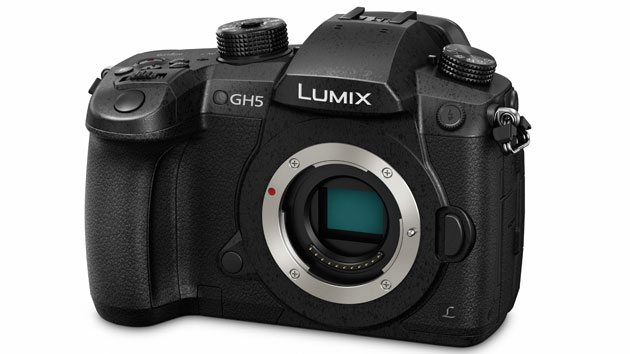Mirrorless Camera Boasts On-Board 8-Bit 60p and 10-Bit 30p 4K Video Recording
After raising a ruckus with a mere prototype at Photokina last year, Panasonic finally took the wraps off the Lumix GH5, its new flagship MFT mirrorless camera, at CES today in Las Vegas.
It may still look like a still camera, but the GH5 is a video powerhouse — as promised, Panasonic said the new camera will deliver your choice of 8-bit 4K recording to dual SD cards at up to 60p, or 10-bit 4K 4:2:2 video recording at up to 30p.
Users have access to Cinelike D and Cinelike V film-style gamma settings, as well as "Like 709" for HDTV production. With a paid software upgrade, users can record using the V-LogL color profile, as well.
Pro video features include waveform monitor and vectorscope, SMPTE-compliant timecode and color bars, selectable luminance levels, and a "synchro-scan" mode for flicker suppression.
The total pixel count has been increased by about 25% with a new MOS-type sensor boasting 20.3 megapixels and a new image-processing engine, Venus, that the company said improves the appearance of natural textures. A combination of speed improvements in readout from the sensor and processing in the Venus Engine allows high-frame-rate UHD video to be recorded in camera, Panasonic said. The video frame is sampled from the full sensor, not cropped, and rolling-shutter distortion is suppressed.
Available file formats include MOV, MP4, AVCHD Progressive and AVCHD, with no recording limit for HD and 4K video. The system frequency can be set to 59.94Hz, 50Hz or 24Hz, Panasonic said.
What will it cost you? The camera body only is expected to ship in late March for $2,000 — a little more than the GH4 at launch. And not all of the functionality will be available from day one. In April, Panasonic expects a firmware update to enable 4:2:2 10-bit video recording in full HD. Later in the year, more updates will enable 400 Mbps 4:2:2 10-bit all-Intra video recording in 4K (30p/25p/24p), full HD anamorphic-mode video recording; HLG in Photo Style mode for HDR 4K video recording, and USB tethering.
Lumix Lounge: lumixlounge.com
Sections: Technology
Topics: New product 4K ces2017 lumix gh5 mirrorless Panasonic
Did you enjoy this article? Sign up to receive the StudioDaily Fix eletter containing the latest stories, including news, videos, interviews, reviews and more.

Leave a Reply